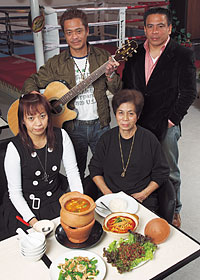Living in Japan
Muay Thai Kickboxing:
Japan and Thailand Reach Out to Each Other
Weerasakreck Wonpasser
Written by Takahashi Hidemine Photos by Akagi Koichi

“I want more Japanese to learn Muay Thai kickboxing. It’s another way to learn Thai culture.” When Weerasakreck Wonpasser (41) speaks, his firm voice certainly holds your attention. That is his fighting name—his name outside the ring is Klahan Prapun.
Muay Thai is a Thai term meaning “combat sport of Thailand.” Muay Thai began there in the 14th century. Boxers use their fists, of course, but they also use their knees to kick and their elbows to jab.
Weerasakreck opened Japan’s first Muay Thai gym in 1997, in Arakawa, Tokyo. He now has eight gyms in different parts of Japan—in Tokyo, Chiba, Saitama and Fukuoka prefectures.
“Our motto is, ‘Have fun while you train.’ If it’s not fun, people won’t keep coming for long.”
It is easy to feel at home at his gym in Abiko, Chiba Prefecture. Many women come here to get their weight down. Members, who vary in age from 6 to over 60, train under the hands of Thai coaches and Muay Thai world champions hired by the gym.
Weerasakreck was 15 when he began Muay Thai kickboxing in his hometown, Yasothon, Thailand. He showed great potential and when he was 18 a scout placed him in a gym in the capital city, Bangkok. The potential quickly became solid success and he started up the ranks. Then in 1991 he landed in Japan to challenge the Japanese kickboxing champion.
“My division was bantamweight, but it was marked wrong on the papers so I ended up being placed against a welterweight—that’s almost 10 kg heavier. So I did the only thing I could do—eat a lot and put on weight, and then, meet him in the ring.”
The odds were against him but he was decided the winner.
Next came face-offs against Japan’s champion middleweights and heavyweights. He beat them all. He started out in Japan at 59 kg, and was now up to 70.
“Then there was nobody left in Japan to challenge. So I decided to open a gym.”
In those days, kickboxing gyms in Japan were heavy in hard and strict training. “I found them all kind of oppressive. So I told myself, ‘If I’m going to get people to come and pay every month, my gym has to be what they want.’ So I put up a big sign that said, ‘Lose weight and kick that stress!’”
It just so happened that in the early 1990s, around the time he arrived in Japan, combat sports were taking off. Middleweights and heavyweights were storming Japan with a new style of kickboxing, and it became common for different combat sports to be held the same day in the same ring. TV coverage was extensive, of course. And when the Muay Thai boxers showed their stuff, the sport attracted instant attention. Membership at his gym soared.
Today, his eight gyms have about 500 members altogether. He recently opened a Thai restaurant on the second floor of the gym building in Abiko, and plans to establish a Thai language school on the third floor.
“One day, I’d like to have a network of Muay Thai gyms throughout Japan. If I set my mind to it, I’m sure I’ll succeed. After all, when I arrived in Japan, just about all I had in my suitcase was a pair of boxing shorts, and look at me now.”
Weerasakreck’s face shows he has plenty to smile about. ![]()

Wanrop Weerasakreck, a professional boxer, makes a kick during training.
Weerasakreck Fairtex Muaythai Gym Japanese-language website:
http://www.muaythai.jp/
